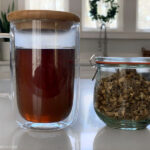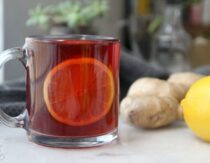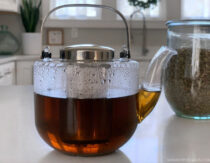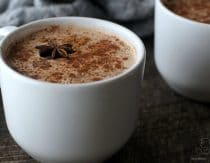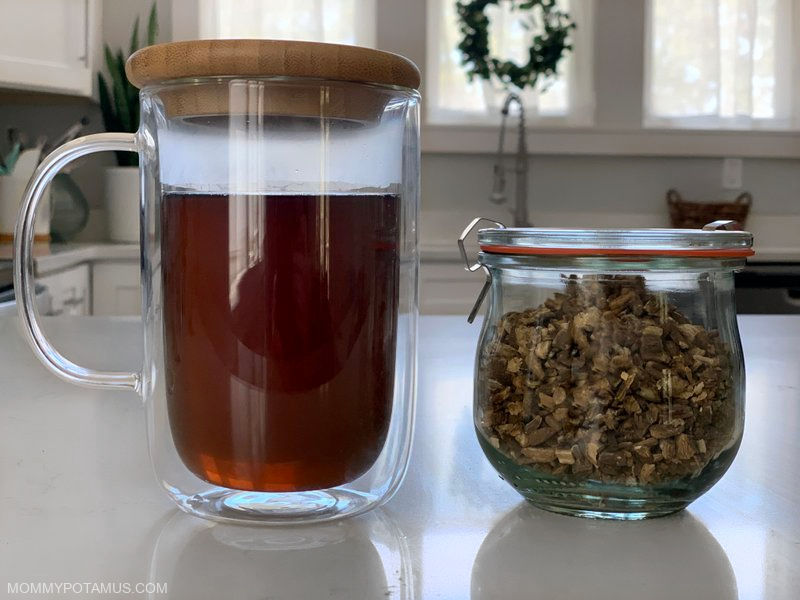
Which herb inspired velcro and just so happens to be “one of the safest, tastiest, and most effective detoxifying and cleansing herbs in Western and Traditional Chinese Medicine”? (1) Burdock root, of course!
For thousands of years this relative of daisies and sunflowers has been used to support lymph flow, liver and blood detoxification, skin clarity, and more.
In this article we’ll dive into its benefits, plus how to make a delicious burdock root tea.
As always, I want to mention that none of these statements have been evaluated by the FDA, this article is not medical advice, and it is not meant to diagnose or treat any condition. Please talk with your healthcare provider about any herbs or supplements you are considering. Now that we’ve got that out of the way, let’s dive in.
- What is burdock?
- 8 Health Benefits of Burdock Root
- 1. Lymphatic & Immune Support
- 2. Detox Support
- 3. Antioxidant Support
- 4. Digestion & Gut Health
- 5. Skin Health & Clarity
- 6. Seasonal Allergy Support
- 7. Supports Healthy Metabolic Function
- 8. Cardiovascular Health
- Bonus Benefit: May Be An Aphrodisiac
- Uses of Burdock Root
- How To Make Burdock Root Tea
- How To Make Burdock Root Tincture
- Does burdock root have any side effects?
- Growing Burdock Root
- Burdock Root Tea Recipe
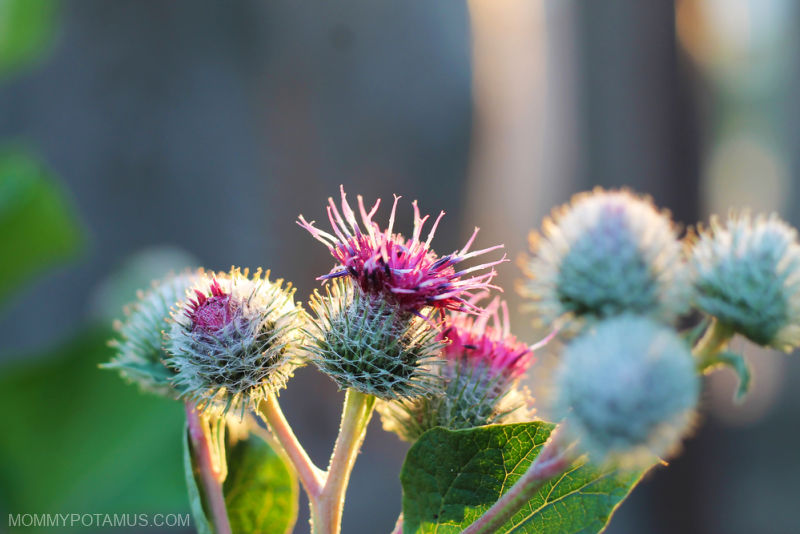
What is burdock? ^
Also called Beggar’s buttons, gobō, happy major, thorny burr, and lappa, the burdock plant (Arctium lappa) belongs to the Asteraceae family. It blooms with vibrant red or purple flowers that look like spiky purple cotton balls.
Almost all parts of the plant are used in traditional herbal medicine – fruit, roots, seeds, flowers, and leaves – but it’s the roots that are most prized for their therapeutic value. (2)(3)(4)(5)(6)
Burdock is native to Europe and Asia and is now easily found in North America, where it spreads cockle-burs (seeds covered in stiff spines) that inspired the invention of velcro.
Here’s the story: In 1941, a Swiss engineer named George de Mestral was hunting with his dog in the Jura mountains when both of them became covered in small burrs from the burdock plant.
As he removed them, De Mestral became curious about how they worked and put them under a microscope. Eight years later, he debuted his invention that mimicked their tiny interlocking hooks and named it velcro.
8 Health Benefits of Burdock Root ^
Traditionally used for a variety of purposes – even as an aphrodisiac – burdock root contains a wide range phytochemicals that are currently being researched for their therapeutic value.
It also contains constituents that nourish beneficial bacteria, and because its taproot reaches deep into the earth (up to 2 feet) it’s also rich in minerals including calcium, copper, iron, magnesium, manganese, potassium, and zinc.
In Medical Herbalism, David Hoffman writes that it helps to move the body toward “a state of integration and health, improving indicators of systemic imbalance, such as skin problems and dandruff.” (7)
Here are some of the ways it’s thought to do that:

1. Lymphatic & Immune Support ^
When you hear the phrase “circulatory system,” do you think of your heart, veins, and arteries? I definitely do . . . but we all have a second circulatory system that deserves our attention.
Our lymphatic system is a passive circulatory system that functions as a vital part of both our immune system and our internal drainage (detoxification) system.
Unlike the cardiovascular system which is powered by the heart, it relies on muscle contractions to “pump” immune cells throughout the body while removing pathogens, toxins, and abnormal cells (detoxification).
Traditionally we moved a lot throughout the day – walking long distances, performing manual labor, etc. – which allowed for good flow of lymph throughout our bodies.
These days, though, we move less while being exposed to far more toxins than our ancestors, making it easy for lymph flow to become sluggish.
Fortunately, in addition to daily movement, there are things we can do to keep our immune cells circulating and our drainage pathways taking out the trash: dry brushing, drinking lots of water, whole body vibration therapy, and of course burdock root tea.
Aviva Romm, M.D., midwife and herbalist lists it as a lymphagogue, which is “an agent that promotes lymph production or lymph flow,” and traditional use supports this therapeutic application. (8)
Personally, supporting lymphatic health is something I have to stay on top of as part of my healing journey. I have found burdock root to be a wonderful “mover and shaker” that helps keep things flowing.
2. Detox Support ^
One of the amazing things about burdock is that its detox support properties don’t stop with the lymphatic system – it also supports the organs we need to drain the gunk-filled lymph fluid. Here’s how it works:
Step 1: Lymph fluid carries waste products (toxins, hormone byproducts, etc.) and destroyed pathogens into the bloodstream.
Burdock root contains lignans, triterpenoids, polyacetylenes and other compounds that promote blood circulation, which is needed to keep the waste products moving toward the exit. (2)
Step 2: Next, the liver or kidneys remove the waste and pathogens from the blood. Burdock is known as a “tried-and-true liver and skin tonic,” so it helps immensely with this part of the detox process. (9)
Specifically, certain antioxidants in burdock root help protect the liver as it breaks down toxins into water-soluble byproducts that can be flushed out (Phase I Detoxification). The break-down process creates a lot of damaging free radicals that the antioxidants counteract, which helps to “maintain the oxidative/antioxidative balance in the liver.” (10)
Burdock root also contains bitter compounds – sometimes referred to as herbal bitters – that encourage the production of bile. In Phase II of liver detoxification, it binds with the toxins and then flows into the bowels for elimination.
Step 3: The body passes the byproducts/pathogens through bowel movements or urine.
Burdock root is known as a mild diuretic (meaning that it supports urine flow), so it helps with this aspect too! It also contains prebiotics that support gut health and therefore healthy bowel elimination.
For detox support, burdock root is often blended with (or used alongside) complementary herbs like dandelion root or stinging nettle leaf.
3. Antioxidant Support ^
We’ve already touched on how antioxidants help the liver, but of course that’s not all they do.
We know that excessive amounts of free radicals – which our bodies produce as byproducts of metabolism – cause oxidative stress that can lead to accelerated aging and several disease processes throughout the body. Fortunately, as this Live Science article puts it,
Antioxidants are able to give an electron to a free radical without becoming destabilized themselves, thus stopping the free radical chain reaction. ‘Antioxidants are natural substances whose job is to clean up free radicals. Just like fiber cleans up waste products in the intestines, antioxidants clean up the free radical waste in the cells,’ said Wright.”
Burdock root is high in antioxidant capacity, which basically means that it contains lots of antioxidants that help counteract free radicals. (11)
Specifically, it’s rich in flavonoids like quercetin and luteolin, phenolic acids, caffeic acid (also found in coffee), tannins (also found in red wine), and lignans such as arctigenin and arctiin. (11)(2)
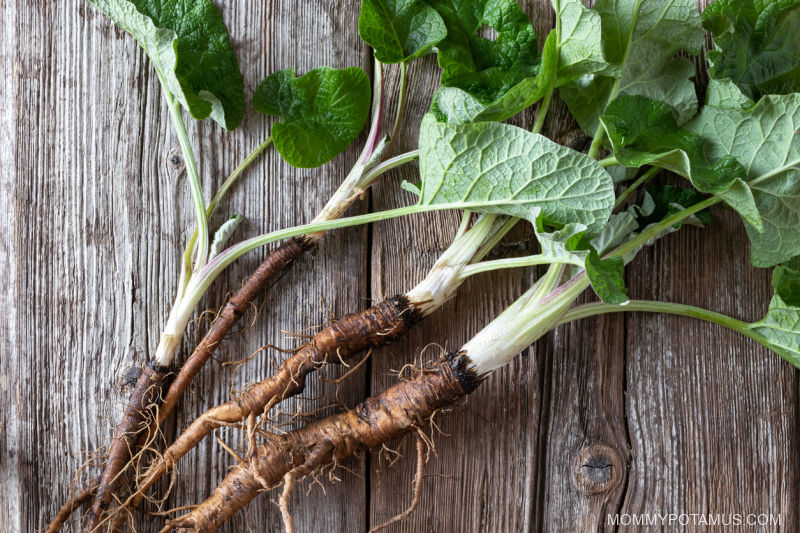
4. Digestion & Gut Health ^
Burdock root is a digestive bitter and prebiotic, which means it contains:
- Bitter flavonoids and lactones that stimulate digestive juices such as stomach acid (HCl), bile, and enzymes so that we can break down and absorb nutrients. Don’t let its classification as a bitter keep you from trying it, though. It’s bitter components are blended with nutty and sweet compounds that make it enjoyable to drink as a tea.
- A prebiotic fiber called inulin, which nourishes the beneficial bacteria in our digestive tract. Hot water and a little time is the best way to extract inulin, which is just another reason to love this recipe.
5. Skin Health & Clarity ^
Taken both internally and externally, burdock root is thought to help with:
Improving skin clarity, especially in teens or anyone with hormone-related blemishes. Because the liver is responsible for clearing away excess hormones and their byproducts, optimizing its function is essential for balancing hormones.
“It is my favorite herb for teenagers who have problem skin, acne, boils and other ‘hot conditions’ due to the shifting hormones of the teen years, and sometimes due to too rich a diet (too much sugar and fast food),” writes Rosemary Gladstar. (1)
For skin issues, it’s often sipped as a tea daily, either by itself or blended with yellow dock, red clover or cleavers. (12)
It also contains polyacetylenes which are thought to be helpful when the tea is applied topically.
Soothing itchy or irritated skin. When applied topically, burdock root tea is thought to be helpful for soothing eczema, itchiness and more. Here’s what Rosemary Gladstar has to say:
Burdock also makes an effective wash for dry, itchy, irritated skin. Decoct the root, and apply a cloth soaked in the tea directly to the skin. Or use the tea in bathwater.” (1)
6. Seasonal Allergy Support ^
Like stinging nettle, burdock root is rich in quercetin – a flavonoid that studies suggest may support the stabilization of mast cells (the immune cells that release histamine). (13)
Click here to read more about natural strategies for seasonal allergies.
7. Supports Healthy Metabolic Function ^
Research suggests that burdock root supports the production of insulin, which is the hormone that reduces blood sugar. (14)(7)
It also seems to have a balancing effect on the hormone leptin, which is the hormone that tells us when we’re hungry. When leptin is not functioning properly, it can cause us to feel hungry even when we have adequate nutritional stores. (14)
8. Cardiovascular Health ^
Burdock root contains a compound called arctigenin, which is thought to help maintain healthy blood pressure by supporting the production of nitric oxide. (15)
Nitric oxide is a vasodilator, which means it relaxes the inner muscles of blood vessels, causing them to widen. This vasorelaxation effect increases blood flow and eases tension within blood vessel walls.
Bonus Benefit: May Be An Aphrodisiac ^
Though no human studies have been conducted – unless, uh, you count your own personal research – one animal study did find that burdock root had an aphrodisiac effect. (16) More research is needed, but the findings so far align with its traditional use as an aphrodisiac.
Uses of Burdock Root ^
Dried and fresh burdock root are used both as food and medicine in many parts of the world. If you’re lucky enough to come across fresh roots at your local health food store or farmer’s market – it’s sometimes listed under the name gobō root – I recommend shredding it and then adding it to stir fry.
Important note: Make sure to buy from a reputable retailer who knows herbs well, because burdock can be confused with toxic belladonna plants.
For tinctures and teas, dried burdock root works beautifully and can be easily and safely sourced online. You’ll find instructions for making both below, along with general safety information and tips for growing burdock at home.
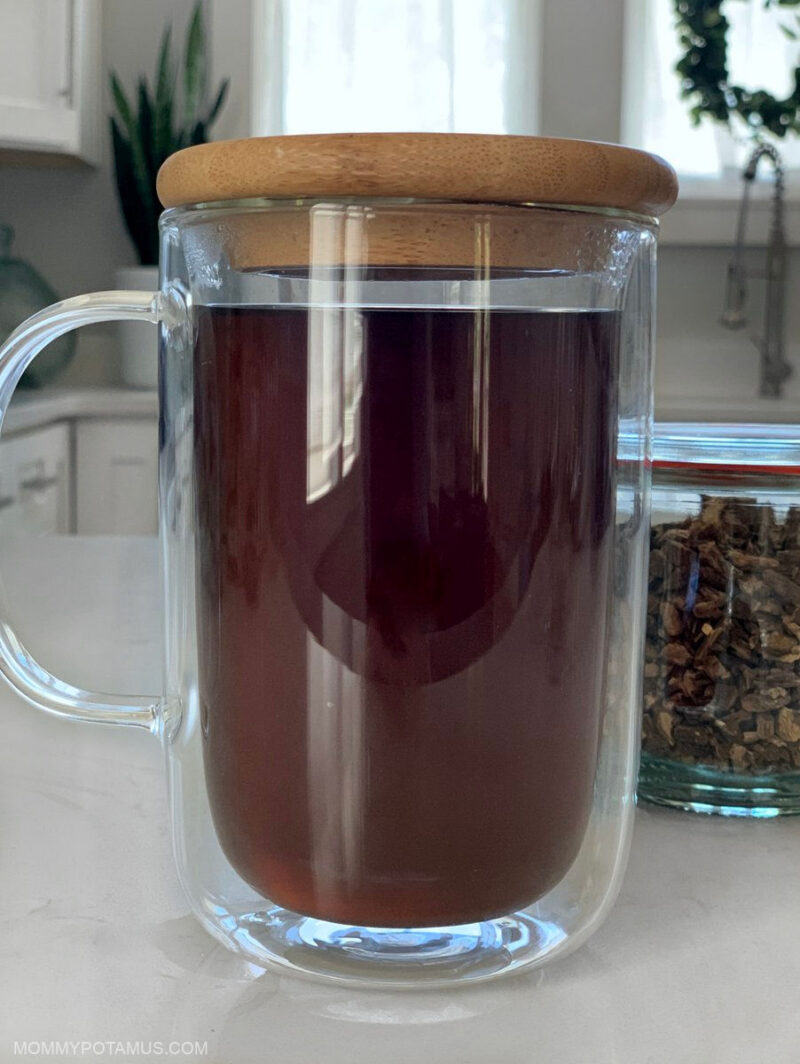
How To Make Burdock Root Tea ^
Scroll to the bottom of this article for a printable version of this recipe.
With its nutty, sweet, and bitter flavor profile, burdock root is perfect for brewing into tea. Like dandelion root, it can be roasted to increase its antioxidant concentration and nutty flavor. (17)
It can also be brewed without roasting to maximize the amount of inulin (prebiotics) present in the final cup. You’ll find instructions for both methods below.
Also, The Herbal Apothecary and other herbal sources recommend drinking burdock root tea 1-3 times per day, so I make one batch in the morning that I sip on throughout the day. Below is my recipe for a triple batch, aka three servings for use throughout the day. If you just want to make one serving use the amounts found in parenthesis.
- 1-2 tablespoons dried organic burdock root (Or 1-2 tsp for single serving)
- 3 cups water (Or 1 cup for single serving)
Instructions for Making Unroasted Burdock Root Tea (My Usual Method)
- Add water and dried burdock root to a pot and bring to a boil.
- Reduce heat, then cover the pot with a lid and simmer for 10-12 minutes.
- Strain out the roots and serve.
Instructions for Making Roasted Burdock Root Tea
- Place a medium pot over medium heat and place the dried burdock root in the bottom.
- Toast the root until it becomes fragrant, then add the water and bring to a boil.
- Reduce heat, then cover the pot with a lid and simmer for 10-12 minutes.
- Strain out the roots and serve.
How To Make Burdock Root Tincture ^
The Modern Herbal Dispensatory recommends a 1:5 tincture (this is a ratio of herb to alcohol) with the alcohol being at least 100 proof (50% alcohol). Here’s how to make it:
Ingredients
- 1 ounce dried organic burdock root (by weight)
- 5 ounces of 100 proof or higher alcohol (by volume)
To Make
- Add 1 ounce of dried burdock root (by weight) to a 16 ounce jar. Pour the alcohol over the root, then cover the with a lid and shake it well. If desired, write the start date on the jar using a sticky note, label, or piece of tape – it makes keeping track of how long it’s been steeping easier.
- Place the jar in a dark, room temperature area. (I keep mine in a kitchen cabinet.) Let the mixture steep for 3-5 more weeks. Shake occasionally.
- When it’s ready, strain the mixture through a cheesecloth, making sure to squeeze out as much liquid as possible. Pour the tincture in a clean jar or dropper bottle and store it in a cool, dark area.
To Use
The Modern Herbal Dispensatory suggests 1-5 ml (0.2 – 1 tsp) 3 times daily.
Does burdock root have any side effects? ^
Rosemary Gladstar calls it “one of the safest, tastiest, and most effective detoxifying and cleansing herbs in Western and Traditional Chinese Medicine,” and the Botanical Safety Handbook lists it as a Safety Class 1A herb (the safest rating possible).
It is described as:
- “Herbs that can be safely consumed when used appropriately.
- History of safe traditional use
- No case reports of significant adverse events with high probability of causality
- No significant adverse events in clinical trials
- No identified concerns for use during pregnancy or lactation
- No innately toxic constituents
- Toxicity associated with excessive use is not a basis for exclusion from this class
- Minor or self-limiting side effects are not bases for exclusion from this class”
With that said, burdock may cause allergic reactions in people who are sensitive to plants in the Asteraceae family – for example, ragweed, daisies, marigolds, and chrysanthemums.
Always buy from knowledgeable, reputable sellers and don’t collect burdock root in the wild. It looks similar to a toxic nightshade plant called belladonna and the two often grow together.
Growing Burdock Root ^
For most people, the question is how not to grow burdock. It is a happily aggressive, tenacious weed that thrives across the continent. Its round, prickly seedpod, cleverly designed to attach to whatever passes by – animal, bird, person, it’s not fussy – is a highly effective mechanism of seed dispersal, and was the inspiration behind velcro. Burdock is an easy grower and will do well in poor soil, fertile soil, rocky soil, or what have you. It survives freezing temperatures but does equally well in warmer weather. It is drought resistant but appreciates a bit of rain now and again.” (Rosemary Gladstar’s Medicinal Herbs)
Here are some tips for growing it:
- Thrives in zones 2-10
- Prefers neutral pH
- Grows in any soil, but if you want to gather the roots it can be difficult to do in compacted soil. Before planting, it may be helpful loosen up the soil by adding wood chips, a bit of sand, or whatever your local garden expert suggests
- Plant in the spring after the likelihood of frost has passed. Burdock likes full sun or partial shade. It can grow to be very large, so keep that in mind when choosing where to plant it.
- Seeds should be planted about 2 inches apart and 3/4 inch deep in rows that are 24 inches apart. When the seedlings come up, thin them so that each plant is 2-3 feet apart.
- Because of its “velcro” seeds, burdock may begin popping up all around your yard if you don’t contain them. The best way to prevent this is to snip the burs before they form.
Burdock Root Tea Recipe ^
Ingredients
- 1-2 tbsp dried organic burdock root (Or 1-2 tsp for a single serving)
- 3 cups water (Or 1 cup for a single serving)
Instructions
Unroasted Burdock Root Tea (My Usual Method)
- Add water and dried burdock root to a pot and bring to a boil.
- Reduce heat, then cover the pot with a lid and simmer for 10-12 minutes.
- Strain out the roots and serve.
Roasted Burdock Root Tea
- Place a medium pot over medium heat and place the dried burdock root in the bottom.
- Toast the root until it becomes fragrant, then add the water and bring to a boil.
- Reduce heat, then cover the pot with a lid and simmer for 10-12 minutes.
- Strain out the roots and serve.
Nutrition
Want more research-backed natural remedies?
No problem, I’ve created a free ebook for you – Kitchen Apothecary: 25+ Natural Remedies Using Ingredients From Your Pantry – as a gift for signing up for my newsletter. You’ll also get updates when I post about safe essential oils for pregnant/breastfeeding mamas, exclusive gifts and coupons (I was able to give away a jar of free coconut oil to anyone who wanted it recently!), plus other goodies.
Sign up using the form below.
Sources
1. Gladstar, Rosemary (2012) Rosemary Gladstar’s Medicinal Herbs
2. Chan, Yuk-Shing et. al. (2010) A review of the pharmacological effects of Arctium lappa (burdock)
3. Ling, Ji et. al. (2013) Determination of fructooligosaccharides in burdock using HPLC and microwave-assisted extraction
4. Zheng, Zhenjia et. al. (2018) Semi-Preparative Separation of 10 Caffeoylquinic Acid Derivatives Using High Speed Counter-Current Chromatogaphy Combined with Semi-Preparative HPLC from the Roots of Burdock (Arctium lappa L.)
5. Rakesh Jaiswal and Nikolai Kuhnert (2011) Identification and characterization of five new classes of chlorogenic acids in burdock (Arctium lappa L.) roots by liquid chromatography/tandem mass spectrometry
6. Liu, Jingyi et. al. (2012) Comparative analysis of caffeoylquinic acids and lignans in roots and seeds among various burdock (Arctium lappa) genotypes with high antioxidant activity
7. Hoffman, David (2003) Medical Herbalism: The Science Principles and Practices Of Herbal Medicine
8. Romm, Aviva. (2014) Botanical Medicine For Women’s Health, First Edition.
9. Pursell, JJ (2015) The Herbal Apothecary: 100 Medicinal Herbs & How To Use Them
10. Sael Casas-Grajales and Pablo Muriel (2015) Antioxidants in liver health
11. Ferracane, Rosalia (2010) Metabolic profile of the bioactive compounds of burdock (Arctium lappa) seeds, roots and leaves
12. Hoffman, David (2016) The Complete Herbs Sourcebook
13. Horowitz, Randy (2018) Integrative Medicine
14. Ahangarpour, Akram et. al. (2017) Antidiabetic, hypolipidemic and hepatoprotective effects of Arctium lappa root’s hydro-alcoholic extract on nicotinamide-streptozotocin induced type 2 model of diabetes in male mice
15. Anwar, M. Akhtar (2016) Anti-Hypertensive Herbs and Their Mechanisms of Action: Part II
16. JianFeng, Cao (2012) Effect of aqueous extract of Arctium lappa L. (burdock) roots on the sexual behavior of male rats
17. Darye Lee and Choon Young Kim (2017) Influence of Roasting Treatment on the Antioxidant Activities and Color of Burdock Root Tea

